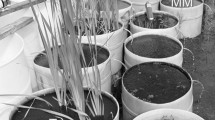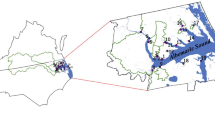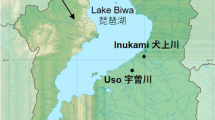Abstract
Nutrient concentrations, benthic algal biomass, dissolved oxygen (DO), and pH were measured in 70 or more streams during spring and summer in the Illinois River Watershed (IRW), which crosses the Oklahoma and Arkansas (USA) border, to determine whether injury to streams occurred and if that injury was related to spreading poultry waste on fields. Definitions of injury were based on Oklahoma water quality regulations and scientific literature. Phosphorus and nitrogen concentrations were each independently related to poultry house density (PHD) in watersheds and percent urban land use in watersheds. In addition, phosphorus and nitrogen concentrations were unusually high compared to regions with similar geology and hydrology. Molar N:P ratios were high and indicated that phosphorus was the most likely limiting nutrient. Phosphorus concentrations, as well as PHD and urban land use, were related to algal biomass during spring, but were less related during summer. A threshold response in cover of stream bottoms by nuisance filamentous green algae (NFGA: Cladophora, Rhizoclonium, and Oedogonium) during spring was observed at 27 μg TP l−1 using regression tree analysis. Great increases in average NFGA cover (from 4 to 36% cover) occurred with relatively small increases in TP concentration at the 27 μg TP l−1 threshold. Average concentrations of DO, variability in DO, and pH during spring were positively related to TP, chlorophyll a, and NFGA cover. Minimum DO during spring and early morning DO during summer were negatively related to TP concentration. Spring pH and summer DO frequently violated water quality requirements for protecting biodiversity that were established by the state of Oklahoma. We conclude that poultry house operations as well as urban activities, independently and interactively, pollute IRW streams with phosphorus, which resulted in injury to aesthetic condition and the potential for injury of biodiversity.







Similar content being viewed by others
References
Allan, J. D., D. L. Erickson & J. Fay, 1997. The influence of catchment land use on stream integrity across multiple spatial scales. Freshwater Biology 37: 149–161.
APHA, 1998. Standard Methods for the Evaluation of Water and Wastewater, 20th ed. American Public Health Association, Washington, DC.
Auer, M. T., M. S. Kieser & R. P. Canale, 1986. Identification of critical nutrient levels through field verification of models for phosphorus and phytoplankton growth. Canadian Journal of Fisheries and Aquatic Sciences 43: 379–388.
Beyers, D. W., 1998. Causal inference in environmental impact studies. Journal of the North American Benthological Society 17: 367–373.
Biggs, B. J. F., 1995. The contribution of flood disturbance, catchment geology and land use to the habitat template of periphyton in stream ecosystems. Freshwater Biology 33: 419–438.
Biggs, B. J. F., 2000. Eutrophication of streams and rivers: dissolved nutrient–chlorophyll relationships for benthic algae. Journal of the North American Benthological Society 19: 17–31.
Bothwell, M. L., 1989. Phosphorus-limited growth dynamics of lotic periphytic diatom communities: areal biomass and cellular growth rate responses. Canadian Journal of Fisheries and Aquatic Sciences 46: 1293–1301.
Carpenter, S. R., N. F. Caraco, D. L. Correll, R. W. Howarth, A. N. Sharpley & V. H. Smith, 1998. Nonpoint pollution of surface waters with phosphorus and nitrogen. Ecological Applications 8: 559–568.
Cooke, G. D., E. B. Welch & J. R. Jones, 2011. Eutrophication of Tenkiller Reservoir, Oklahoma, from nonpoint agricultural runoff. Lake and Reservoir Management 27: 256–270.
Dodds, W. K. & D. A. Gudder, 1992. The ecology of Cladophora. Journal of Phycology 28: 415–427.
Dodds, W. K. & R. M. Oakes, 2004. A technique for establishing reference nutrient concentrations across watersheds affected by humans. Limnology and Oceanography: Methods 2: 331–341.
Dodds, W. K., V. H. Smith & B. Zander, 1997. Developing nutrient targets to control benthic chlorophyll levels in streams: a case study of the Clark Fork River. Water Research 31: 1738–1750.
Dudley, T. L., S. D. Cooper & N. Hemphill, 1986. Effects of macroalgae on a stream invertebrate community. Journal of the North American Benthological Society 5: 93–106.
Fisher, J. B., R. L. Hight, R. van Waasbergen, B. Engle & M. Smith, 2009. Estimates of the mass generated, disposal timing and the spatial distribution of disposal sites within the Illinois River Watershed (Oklahoma and Arkansas, United States). In Li, S., Y. Wang, F. Cao, P. Huang & Y. Zhang (eds), Progress in Environmental Science and Technology, Vol. II, Part B. Proceedings of the 2009 International Symposium on Environmental Science and Technology, Shanghai, China, June 2–5, 2009. Science Press, Beijing, P. R. China: 1238–1247.
Francoeur, S. N., 2001. Meta-analysis of lotic nutrient amendment experiments: detecting and quantifying subtle responses. Journal of the North American Benthological Society 20: 358–368.
Garvey, J. E., M. R. Whiles & D. Streicher, 2007. A hierarchical model for oxygen dynamics in streams. Canadian Journal of Fisheries and Aquatic Sciences 64: 1816–1827.
Johnson, L. B., C. Richards, G. E. Host & J. W. Arthur, 1997. Landscape influences on water chemistry in Midwestern stream ecosystems. Freshwater Biology 37: 193–208.
Karr, J. R. & D. R. Dudley, 1981. Ecological perspective on water quality goals. Environmental Management 5: 55–68.
MacKenthun, K. M., 1968. The phosphorus problem. Journal American Water Works Association 60: 1047–1054.
Millennium Ecosystem Assessment, 2005. Ecosystems and Human Well-being: Synthesis. Island Press, Washington, DC.
Miltner, R. J. & E. T. Rankin, 1998. Primary nutrients and the biotic integrity of rivers and streams. Freshwater Biology 40: 145–158.
Muradian, R., 2001. Ecological thresholds: a survey. Ecological Economics 38: 7–24.
Odum, H. T., 1956. Primary production in flowing waters. Limnology and Oceanography 1: 102–117.
Oklahoma Administrative Code, 2010. Title 785. Oklahoma Water Resources Board. Chap. 45. Oklahomas Water Quality Standards [available on internet at http://www.owrb.ok.gov/util/rules/pdf_rul/2010adopted/Adopted2010_Ch45.pdf].
Pan, Y., R. J. Stevenson, B. H. Hill, A. T. Herlihy & G. B. Collins, 1996. Using diatoms as indicators of ecological conditions in lotic systems: a regional assessment. Journal of the North American Benthological Society 15: 481–495.
Redfield, A. C., 1958. The biological control of chemical factors in the environment. American Scientist 46: 205–221.
Rier, S. T. & R. J. Stevenson, 2006. Response of periphytic algae to gradients in nitrogen and phosphorus in streamside mesocosms. Hydrobiologia 561: 131–147.
Riseng, C. M., M. J. Wiley & R. J. Stevenson, 2004. Hydrologic disturbance and nutrient effects on benthic community structure in midwestern US streams: a covariance structure analysis. Journal of the North American Benthological Society 23: 309–326.
Sharpley, A. N., S. Herron & T. Daniel, 2007. Overcoming the challenges of phosphorus based management in poultry farming. Journal of Soil and Water Conservation 62: 375–389.
Smith, V. H., G. D. Tilman & J. C. Nekola, 1999. Eutrophication: impacts of excess nutrient inputs on freshwater, marine, and terrestrial ecosystems. Environmental Pollution 100: 179–196.
Stevenson, R. J., 1997. Resource thresholds and stream ecosystem sustainability. Journal of the North American Benthological Society 16: 410–424.
Stevenson, R. J. & L. L. Bahls, 1999. Periphyton Protocols. In Barbour, M. T., J. Gerritsen & B. D. Snyder (eds), Bioassessment Protocols for Use in Wadeable Streams and Rivers: Periphyton, Benthic Macroinvertebrates, and Fish, Chap 6, 2nd ed. US Environmental Protection Agency, Washington, DC: 1–22.
Stevenson, R. J. & S. Sabater, 2010. Understanding effects of global change on river ecosystems: science to support policy in a changing world. Hydrobiologia 657: 3–18.
Stevenson, R. J., S. T. Rier, C. M. Riseng, R. E. Schultz & M. J. Wiley, 2006. Comparing effects of nutrients on algal biomass in streams in two regions with different disturbance regimes and with applications for developing nutrient criteria. Hydrobiologia 561: 140–165.
Stevenson, R. J., B. E. Hill, A. T. Herlihy, L. L. Yuan & S. B. Norton, 2008. Algal–P relationships, thresholds, and frequency distributions guide nutrient criterion development. Journal of the North American Benthological Society 27: 783–799.
Stoddard, J. L., D. P. Larsen, C. P. Hawkins, R. K. Johnson & R. H. Norris, 2006. Setting expectations for the ecological condition of streams: the concept of reference condition. Ecological Applications 16: 1267–1276.
Suplee, M. W., V. Watson, M. Teply & H. McKee, 2008. How green is too green? Public opinion of what constitutes undesirable algae levels in streams. Journal of the American Water Works Association 44: 1–18.
Tarkalson, D. & R. Mikkelsen, 2003. A phosphorus budget of a poultry farm and a dairy farm in the southeastern US, and the potential impacts of diet alterations. Nutrient Cycling in Agroecosystems 66: 295–303.
Tesoriero, A. J., J. H. Duff, D. M. Wolock, N. E. Spahr & J. E. Almendinger, 2009. Identifying pathways and processes affecting nitrate and orthophosphate inputs to streams in agricultural watersheds. Journal of Environmental Quality 38: 1892–1900.
USEPA, 2007. National Water Quality Inventory: Report to Congress. 2002 Reporting Cycle. EPA 841-R-07-001, United States Environmental Protection Agency, Washington, DC.
Wang, L., D. M. Robertson & P. L. Garrison, 2007. Linkages between nutrients and assemblages of macroinvertebrates and fish in wadeable streams: implication to nutrient criteria development. Environmental Management 39: 194–212.
Weidhaas, J. L., T. W. Macbeth, R. L. Olsen, M. L. Sadowsky, D. Norat & V. J. Harwood, 2010. Identification of a Brevibacterium marker gene specific to poultry litter and development of a quantitative PCR assay. Journal of Applied Microbiology 109: 334–347.
Welch, E. B., J. M. Jacoby, R. R. Horner & M. R. Seeley, 1988. Nuisance biomass levels of periphytic algae in streams. Hydrobiologia 157: 161–168.
Wetzel, R. G., 2001. Limnology: Lake and River Ecosystems, 3rd ed. Academic Press, San Diego.
Wong, S. L., B. Clark, M. Kirby & R. F. Kosduw, 1978. Water temperature fluctuations and seasonal periodicity of Cladophora and Potamogeton in shallow rivers. Journal of the Fisheries Research Board of Canada 35: 866–870.
Acknowledgments
This research was funded by the Office of the Attorney General of Oklahoma. The design and data analysis of the project were benefited by discussions with David Page, Bernie Engel, Roger Olsen, and Bert Fisher. Julie Heinlein, Jan Seidler, Renee Mulcrone, Tony Gendusa, Karthic Poosekar, and Robert van Waasbergen helped with algal sample analysis at Michigan State University or field sampling and data gathering by CDM, Inc.
Author information
Authors and Affiliations
Corresponding author
Additional information
Guest editors: L. Ector, D. Hlúbiková & L. Hoffmann/Proceedings of the 7th International Symposium “Use of Algae for Monitoring Rivers”, Luxembourg, November 23–25, 2009
Rights and permissions
About this article
Cite this article
Stevenson, R.J., Bennett, B.J., Jordan, D.N. et al. Phosphorus regulates stream injury by filamentous green algae, DO, and pH with thresholds in responses. Hydrobiologia 695, 25–42 (2012). https://doi.org/10.1007/s10750-012-1118-9
Received:
Accepted:
Published:
Issue Date:
DOI: https://doi.org/10.1007/s10750-012-1118-9




